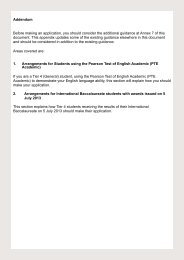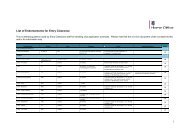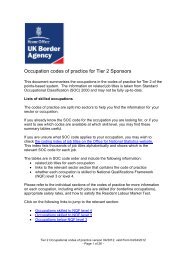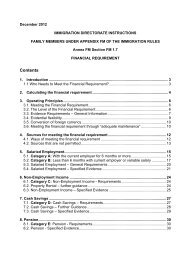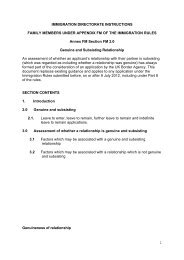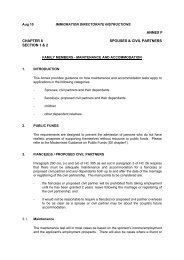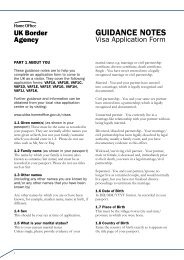COI Report March 2012 - UK Border Agency - Home Office
COI Report March 2012 - UK Border Agency - Home Office
COI Report March 2012 - UK Border Agency - Home Office
You also want an ePaper? Increase the reach of your titles
YUMPU automatically turns print PDFs into web optimized ePapers that Google loves.
7 MARCH <strong>2012</strong> SRI LANKA<br />
The Department of Census and Statistics – Sri Lanka produces estimated mid-year population<br />
figures, the latest being for 2008. These figures show that the estimated population of Sri Lanka<br />
as 20,217,000. The estimated population of Colombo District is given as 2,488,000.<br />
The Central Bank of Sri Lanka produces yearly country profiles, the latest of which is 2010.<br />
They estimated the population of the country as 20,653,000 and the population of Western<br />
Province, which includes the districts of Colombo, Gampaha and Kalutara as 5,865,000:<br />
http://www.cbsl.gov.lk/pics_n_docs/10_pub/_docs/statistics/other/Socio_Econ_%20Data_2011_<br />
e.pdf . The ethnicity breakdown shown in the profile is based on the 1981 census.<br />
There are frequent comments made in conversation in Sri Lanka that, ―There are more Tamils<br />
in Colombo than Sinhalese‖. Published statistics do not support this claim. In some small areas<br />
of Colombo there are indeed a much higher percentage of Tamils than Sinhalese, but equally<br />
there are areas which are considered almost entirely Muslim. In establishing the ethnicity<br />
breakdown, compilers often mix race and religion. Not all Sinhalese are Buddhists, not all<br />
Tamils are Hindus and there are many Muslims and Roman Catholics who are considered<br />
Tamil merely because that is the language they speak. There is additional confusion between<br />
Colombo District and Colombo DSD, and to further confuse matters a widely produced map of<br />
the City of Colombo, shows the city boundary includes the DSDs of Colombo and<br />
Thimbirigasyaya, which could be construed as Colombo metropolitan area.<br />
Thimbirigasyaya DSD to the south of Colombo DSD includes of the areas of Thimbirigasyaya,<br />
Kollupitiya (Colpetty), Cinnamon Gardens, Borella, Bambalapitiya, Narahenpita, Havelock<br />
Town, Wellawatte and Kirillapone. According to the Census of 2001 Information Unit the total<br />
population of Thimbirigasyaya DSD was 263,550, with a breakdown into major religions as<br />
follows:<br />
Buddhist 136,915 – 52%<br />
Hindu 56,719 – 21.5%<br />
Muslim 39,483 – 15%<br />
Roman Catholic 22,507 – 8.5%<br />
Other Christian 7,926 – 3%<br />
A former Chief Justice once told me that there were 400,000 Tamils living in Colombo. Similarly,<br />
Mano Ganesan MP informed me that Colombo District has close to 300,000 Tamils living here<br />
as permanent residents and another 50,000 as temporary residents. Most of the Tamils live<br />
within Colombo City limits but other sizeable numbers live south of the city in the suburbs of<br />
Dehiwala and Mount Lavinia. He added that another 100,000 Tamils reside in Wattala and a<br />
further 50,000 reside further south in Kalutara. This would estimate up to 500,000 living in<br />
Colombo and its immediate environs. Clearly these figures would be with regard to Colombo<br />
District, and based on the 2008 estimated figure above, would indicate that between 16 – 20%<br />
of the total population of the Colombo district are Tamil.<br />
It is widely accepted that there has been a significant movement of population into Colombo<br />
District since 2008 as the civil conflict entered its final phase. People from the five districts of the<br />
Northern Province who had been living in and around Colombo for the past five years were<br />
instructed to register with the police on 21 st September 2008. Figures showed that the number<br />
of people who had migrated from the five districts to Colombo since 21 st September 2003 stood<br />
at 37,037. Out of these, 2,242 were considered new entries, as they had not been previously<br />
The main text of this <strong>COI</strong> <strong>Report</strong> contains the most up to date publicly available information as at 3 February <strong>2012</strong>.<br />
Further brief information on recent events and reports has been provided in the Latest News section<br />
to 2 <strong>March</strong> <strong>2012</strong>.<br />
269



